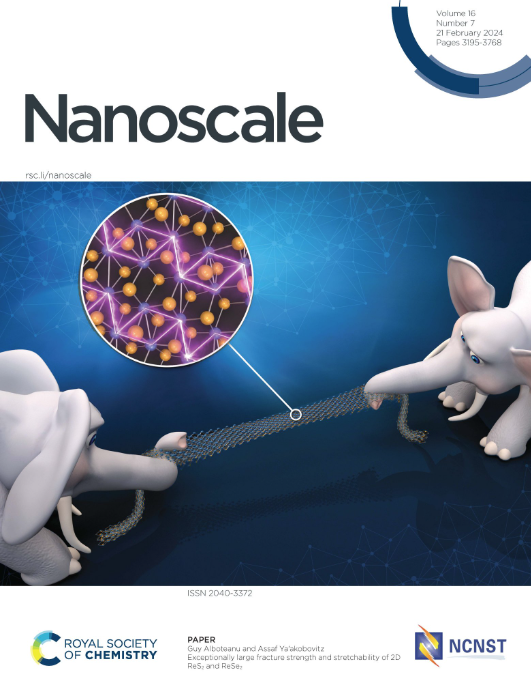Fast and accurate characterization of bioconjugated particles and solvent properties by a general nonlinear analytical relation for the AC magnetic hysteresis area
IF 5.8
3区 材料科学
Q1 CHEMISTRY, MULTIDISCIPLINARY
引用次数: 0
Abstract
Brownian magnetic nanoparticles present a large sensitivity to AC fields, opening new routes to bio-sensing by bio-functionalized nanoparticles. The integration of theory and experiment permit to transduce any magnetic response (via susceptibility, harmonics or hysteresis area) to extract relevant system's parameters (such as particle size, solvent viscosity, temperature). Parameter estimators based on linear response theory are easy to implement, but their sensitivity and resolution is limited by construction. Nonlinear responses allow for much higher sensitivities, but demand a significant cost in complex simulations to fit the experiments, because no analytical relation is available. Here we have solved this dilemma by deriving an empirical analytical relation for the magnetic hysteresis area which is valid under arbitrary field intensity and frequency, thus avoiding the need of calibration. This universal relation matches within 1% the outcome of the nonlinear Fokker-Planck equation and has been validated against detailed Brownian dynamic simulations and controlled experiments. Using this nonlinear magnetic hysteresis area relation, we have built an extremely fast automated-searching algorithm which simultaneously estimates several system's parameters by fitting experimental data for the area (at varying intensity and frequency). The searching scheme starts with a robust and flexible stochastic method (parallel tempering Monte Carlo) followed by an accurate deterministic multi-variable minimization (Gauss-Newton) to match experimental areas within ~1% deviation. This integrated approach upgrades AC-magnetometry into a \emph{stand-alone technique} able to determine, with outstanding accuracy, particle size, polydispersity, concentration, magnetic moment as well as solvent viscosity and temperature. We validate this method in biosensing protocols, by determining nanometer-size variations in bio-functionalized nanoparticles upon protein-target recognition.利用交流磁滞区一般非线性解析关系快速准确地表征生物共轭粒子和溶剂性质
布朗磁性纳米粒子对交流磁场具有很高的灵敏度,为生物功能化纳米粒子的生物传感开辟了新的途径。理论和实验的结合允许转换任何磁响应(通过磁化率,谐波或滞后面积)来提取相关的系统参数(如粒度,溶剂粘度,温度)。基于线性响应理论的参数估计器易于实现,但其灵敏度和分辨率受结构的限制。非线性响应允许更高的灵敏度,但由于没有可用的分析关系,在复杂的模拟中需要大量的成本来拟合实验。本文通过推导出在任意场强和频率下均有效的磁滞面积经验解析关系式,解决了这一难题,从而避免了校准的需要。这个普遍关系在1以内匹配% the outcome of the nonlinear Fokker-Planck equation and has been validated against detailed Brownian dynamic simulations and controlled experiments. Using this nonlinear magnetic hysteresis area relation, we have built an extremely fast automated-searching algorithm which simultaneously estimates several system's parameters by fitting experimental data for the area (at varying intensity and frequency). The searching scheme starts with a robust and flexible stochastic method (parallel tempering Monte Carlo) followed by an accurate deterministic multi-variable minimization (Gauss-Newton) to match experimental areas within ~1% deviation. This integrated approach upgrades AC-magnetometry into a \emph{stand-alone technique} able to determine, with outstanding accuracy, particle size, polydispersity, concentration, magnetic moment as well as solvent viscosity and temperature. We validate this method in biosensing protocols, by determining nanometer-size variations in bio-functionalized nanoparticles upon protein-target recognition.
本文章由计算机程序翻译,如有差异,请以英文原文为准。
求助全文
约1分钟内获得全文
求助全文
来源期刊

Nanoscale
CHEMISTRY, MULTIDISCIPLINARY-NANOSCIENCE & NANOTECHNOLOGY
CiteScore
12.10
自引率
3.00%
发文量
1628
审稿时长
1.6 months
期刊介绍:
Nanoscale is a high-impact international journal, publishing high-quality research across nanoscience and nanotechnology. Nanoscale publishes a full mix of research articles on experimental and theoretical work, including reviews, communications, and full papers.Highly interdisciplinary, this journal appeals to scientists, researchers and professionals interested in nanoscience and nanotechnology, quantum materials and quantum technology, including the areas of physics, chemistry, biology, medicine, materials, energy/environment, information technology, detection science, healthcare and drug discovery, and electronics.
 求助内容:
求助内容: 应助结果提醒方式:
应助结果提醒方式:


